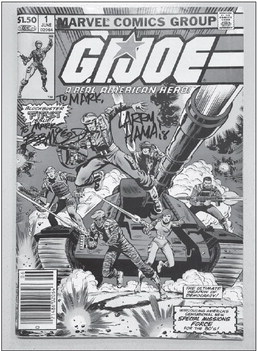A conversation with Larry Hama

A conversation with Larry Hama
G. I. Joe creative force recalls career work on the ‘ Real American Hero’
news@theeveningtimes.com When Hasbro, a Rhode Island based toy company, came out with a line of 3 and 3-3/4 inch G.I. Joe “action figures” in 1982, my 11 yearold self thought they were the coolest toys on the planet.
They were different from other Army toys. These guys had code names like “Snake Eyes,” “Stalker,” “Short Fuze,” “Rock n’ Roll” and they fought against a group of bad guys called COBRA. My friends and I went out and bought all of the original Joes had all kinds fun foiling the bad guys.
Not only that, we got to follow their adventures in a monthly comic book by Marvel.
Playing with G.I. Joe and reading that Marvel comic is among my fondest memories of growing up.
So imagine my delight when I found out that Larry Hama, who wrote the G.I. Joe comic and came up with all those cool Joe characters, was going to be appearing at the Memphis Comic Expo.
I dug out my copy of GI Joe #1 and #2 and had him sign them for me. And as an added bonus, Bob McLeod who drew the cover was there and he signed my GI Joe comic as well.
I got a chance to interview Hama and we spoke about how the G.I. Joe comic came about.
Hama was literally the last person Marvel asked to write G.I. Joe. Back then, no artist or writer wanted to do a comic based on a toy. The average comic based on a toy line only lasted about two years. And with licensing fees, artists and writers were paid less to do them.
“Within the industry, toy books were considered bottom of the barrel,” Hama said. “Nobody but a C-list or D-list writer or artist would work on them. They offered it to all of the contract and noncontract writers and everybody turned them down. Jim Shooter, the editor-in-chief, went from office to office and asked all of the editors and assistant editors if they wanted it. My office was the last one in the row.”
But Hama was so excited to finally get his own comic book that he jumped at the chance to take the project on. “I took it because I couldn’t get anybody to give me any writing work,” Hama said. “So I took it on. I thought I would get my foot in the door.”
Hama said the people at Hasbro were trying to get in on the popularity of the Star Wars toy line. They realized that cross promoting the toys with a comic book would boost sales.
“Hasbro had some very smart people,” Hama said. “They wanted a comic and they wanted whoever was best at doing them. So they came to Marvel. They also figured out what Star Wars had. It was basically toy soldiers in disguise. But they had characters with backgrounds. That’s what they wanted for G.I. Joe. Instead of having this generic 12 inch toy with no name, they had lots of little guys with code names and backgrounds.”
Hama said Hasbro basically gave him a blank slate to create those characters. They came in with drawings of what each one looked like with job descriptions like commando, ranger, mortar soldier, and machine gunner. They left the rest up to Hama. Hama came up with the code names and wrote all of the file cards which gave the background of each G.I. Joe and appeared on the back of the package of every action figure. We clipped those out as kids and kept our own file on the Joes.
The Commando figure became “Snake Eyes.” Mortar soldier became “Short Fuze.” Counterintelligence became “Scarlett.” Ranger became “Stalker.
“The first meeting they did the presentation all they had were these figures,” Hama said. “They had job descriptions. That’s all they had. I came up with all of the code names. A lot of the characters are based on people I know.”
Hama said the Marvel team noticed that something was missing though. There weren’t any bad guys for the G.I. Joes to fight.
“The first thing we said was, ‘well, who are the bad guys?’” Hama said. “The Hasbro people went ‘what bad guys?’ So I said ‘well, what are these G.I. Joes going to do? March? They’ve got to have something to do. They’ve got to have an antagonist.’ This just caught them flatfooted. They had never thought of that.”
Hama said Marvel editor Archie Goodwin came up with the idea of making the bad guys a semi-fascist, paramilitary, paranoid conspiracy organization like H.Y.D.R.A who were the bad guys fighting S.H.I.E.L.D in another Marvel comic line.
“He said ‘why don’t we call it something like…’ and he threw something out off the top of his head… ‘let’s call it something like COBRA,’” Hama said. “Then everybody at Hasbro went ‘right!.’ G.I. Joe: A Real American Hero hit the newsstands in June 1982. It featured an eyepopping “Blockbuster first issue” introducing “America’s Sensational New Special Missions Force for the 80’s” with a cover by artists Bob McLeod and Herb Trimpe showing the new G.I. Joes in action. It was like no other comic book I had ever seen before. It was printed on special Baxter paper and cost $1.50. Hasbro also paid Marvel to produce a TV commercial advertising the comic. It was the first time in history that a television ad was used to promote a comic book.
G.I. Joe #1 featured TWO adventures inside. The first story, “Operation Doomsday,” introduced the original 13 members of the team and established G.I. Joe as an elite counterterrorism unit — this was the 1980s , after all — and ended with them foiling a COBRA plot. But it was the second story, “Hot Potato” that really captured my attention.
In that story, Rock n’ Roll, my favorite character, comes to the rescue of Scarlett and Snake Eyes, who are holding off an enemy in some foreign desert locale. Rock n’ Roll steals a RAM, which stands for Rapid Action Motorcycle and has a Gatling cannon mounted on the side, and returns to rescue them just as they are about to run out of ammunition.
I thought that was so neat and I told my parents that I just had to go to the store and get a RAM for my Rock n’ Roll action figure. Life was great!
The first issue of G.I. Joe sold very well. So much so that by 1983, it was Marvel’s best selling subscription title. Sales went from 157,920 copies a month in 1983, to 331,475 copies a month in 1985. The comic received 1,200 fan mail letters a month. Within two months of the toy launch, 20 percent of boys age 5-12 owned at least two G.I. Joe toys.
“It did really well saleswise,” Hama said. “But we never thought it would go into a second year because licensed books didn’t last long. And in fact, toy lines weren’t expected to last that long.”
Hama said G.I. Joe is also credited with getting more kids interested in reading comics.
“It brought huge amounts of kids into comic book stores,” Hama said. “It became a kind of gateway drug. Kids saw the commercials, they went into the comic book shops, and pretty soon they were buying X-Men. Whole batches of kids went to comic shops that wouldn’t have gone in otherwise.”
And with the cross promotional success of G.I. Joe — which also became a cartoon in 1983 — soon another toy line, The Transformers, would also get a Marvel comic, a cartoon series, and sell lots of toys.
“After Star Wars and G.I. Joe, Transformers happened and everyone else got on the bandwagon,” Hama said. “They realized you could have toys and games and all this other stuff. Star Wars, G.I. Joe, and Transformers changed everything.”
Hama said with success of G.I. Joe, Hasbro pretty much left him alone to write the comic.
“In all this time, Hasbro never bounced one of my scripts,” Hama said. “They just left it up to me. They reasoned that I wouldn’t shoot myself in the foot.”
G.I. Joe would run for the next 12 years for a total of 155 issues before being canceled in 1994 due to declining sales. It’s since been revived — with Hama once again writing the comic — but comics and the artwork have changed so much from when I read G.I. Joe, that other than the same characters, I don’t really recognize it anymore. It’s definitely not “my” G.I. Joe any more.
I would go on to collect many more of the G.I Joe action figures. Hasbro introduced about ten new figures each year. Some of my favorites were “Snow Job,” “Gung Ho,” “Roadblock,” and COBRA villains such as “Destro,” “Major Bludd,” and the ninja, “Storm Shadow.” But I stopped buying G.I. Joe around 1986, which was about the time I also stopped reading the comic.
Unfortunately, the success of G.I. Joe did nothing to advance Hama’s career in comics. Other than a few issues here and there on other titles like Wolverine, he never got the chance to write another comic.
“I was told if I worked on a toy book that I would never be offered an A-list book again for the rest of my career,” Hama said. “I’m still writing G.I. Joe. But, G.I. Joe bought me a house basically. So I can’t complain.”
They still leave him alone when it comes to writing G.I. Joe.
“Nobody bothers me because there is no other authority,” Hama said. “What I say the character is, the character is. I don’t have somebody telling me ‘oh that’s not how the character acts.”
GI Joe made the transition to the movies in 2009 with GI Joe: The Rise of Cobra and a sequel in 2013 GI Joe: Retaliation. I have not seen either movie because those aren’t the Joes I remember. I prefer to remember Snake Eyes and Scarlett and Rock N’ Roll the way they were when they first caught my imagination in 1982 and not the 2000s Hollywood reimagined versions.
So what is the lasting appeal of G.I. Joe?
Hama said it is same thing it was when the comic first came out. It’s about the characters and the camaraderie.
“The fantasy is in the camaraderie and the loyalty within the group,” Hama said. “I really don’t think of it as being military, per se. And it’s the same thing with Harry Potter. People think Harry Potter is all about the magic. It’s not about the magic. That’s not the fantasy that makes it work. The fantasy that makes it work is this whole thing of being without adult supervision, this amazing school, and having these incredible friends that you trust with your life.”
I still have my G.I. Joes and comic books somewhere back at my parent’s house in Massachusetts. They’re highly sought after by collectors today. A pristine copy of G.I. Joe #1 is worth about $100.
As for my signed GI Joe #1, I plan to frame it and find a prominent place in my house where I can see it and smile every time so I can be transported back to the days when I was 12.


By Mark Randall


Share